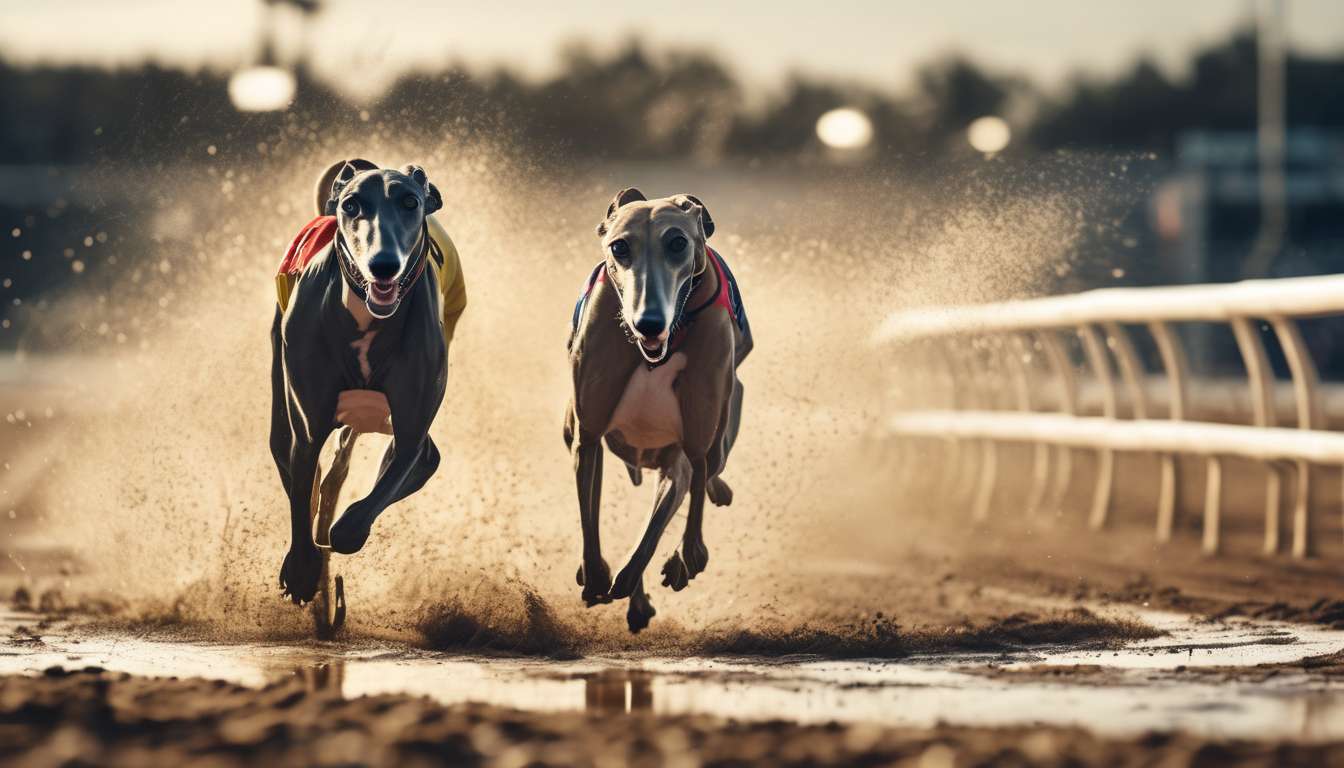As avid enthusiasts of the exhilarating world of greyhound racing, we understand the myriad of factors that influence the outcome of each race. Among these, weather conditions play a pivotal role, often overlooked by the casual observer.
Together, we embark on an exploration of seven critical weather factors that can significantly alter the odds in greyhound racing.
-
Temperature Fluctuations: These can affect the greyhounds’ physical performance, with extreme temperatures potentially causing discomfort or fatigue.
-
Wind Speed and Direction: Wind can either hinder or help the dogs, depending on its direction relative to the race track.
-
Humidity: High humidity levels can impact the dogs’ stamina, as it becomes more challenging for them to cool down during the race.
-
Precipitation: Rain can alter track conditions, making it slippery and affecting the dogs’ agility and speed.
By examining these factors, we aim to enhance our understanding and appreciation of this dynamic sport, equipping ourselves with insights that could transform our approach to predicting race outcomes.
Join us as we navigate the intersection of meteorology and racing strategy, recognizing how these elements shape the performance of these remarkable athletes.
Temperature Fluctuations
Significant temperature fluctuations can impact greyhound performance and thus influence betting odds. We’ve noticed that when the temperature swings from one extreme to another, our greyhounds might not perform as expected. They, like us, are sensitive to their environment, and rapid changes can throw them off their game.
When we gather at the track, we’re not just part of a crowd—we’re a community, invested and attentive. We all know the thrill of watching them race, but temperature isn’t the only factor at play.
Precipitation also has a role, as wet tracks can slow them down. We’ve seen how:
- A sudden downpour
- Even light rain
can change the dynamics of a race.
While wind speed can be a factor, we’ll dive into that later. For now, let’s focus on temperature and precipitation—elements that bring us closer together as we share in the excitement and anticipation of these races, knowing each detail can tip the odds.
Wind Speed Impact
Wind’s Impact on Racing Greyhounds
We’ve all felt the sting of a strong gust, and it’s no different for our racing greyhounds, as wind can dramatically affect their speed and performance on the track. Understanding these factors is crucial for our community.
Wind Speed Effects
- Headwind: Can slow greyhounds down, making each stride more challenging.
- Tailwind: Might give greyhounds the extra push needed to cross the finish line first.
Importance of Wind in Race Conditions
While temperature and precipitation are often considered when discussing race conditions, wind speed is equally essential.
- A sudden increase in wind can alter the odds, impacting our betting decisions.
- When combined with other weather elements like temperature fluctuations or unexpected precipitation, wind becomes a critical variable.
Community Connection
As we look forward to race days, understanding wind speed helps us feel more connected and informed within our greyhound-loving community.
Humidity Levels
Humidity and Greyhound Performance
Humidity levels can subtly influence a greyhound’s performance by affecting their breathing and stamina on race day. As part of our community, we’re all aware that every detail counts when it comes to predicting race outcomes.
Impact of High Humidity
When humidity is high, it can make the air feel warmer than the actual temperature, potentially leading to quicker fatigue for our canine athletes. This is where it becomes vital for us to consider how these conditions might impact the odds.
Interaction with Other Weather Elements
- Humidity can interact with other weather elements, like wind speed.
- A breezy day might provide some relief by helping evaporate sweat and cool the dogs down.
- Without wind, high humidity can be stifling.
Consideration of Combined Weather Conditions
While precipitation is another factor, which we’ll explore soon, it’s essential to remember how the combination of temperature and humidity can create challenging conditions.
Together, let’s keep these factors in mind as we assess the greyhounds’ chances on any given day.
Effects of Precipitation
Rainy days can significantly alter track conditions, impacting both the performance and the odds in greyhound racing. Precipitation affects the track’s surface, often making it slick and challenging for the dogs. This can lead to slower race times and unexpected outcomes.
Temperature Interaction:
- Cooler temperatures can make the track firmer.
- Warmer temperatures may create a muddier surface.
Wind Speed Influence:
Strong winds combined with precipitation can affect a greyhound’s stride and speed, altering how they navigate the track.
As enthusiasts and bettors, understanding these elements helps us make informed decisions. We share a common interest in deciphering these weather patterns to predict race outcomes.
By considering how temperature, precipitation, and wind speed interact, we can better anticipate how these factors influence the odds and performances on race day.
Influence of Fog
Fog and Its Impact on Greyhound Racing
Fog can obscure visibility on the track, making it challenging for greyhounds to maintain their speed and direction. This element of unpredictability not only affects the greyhounds but also enriches our experience as spectators, creating a shared anticipation and excitement.
Weather Elements Influencing Fog:
-
Temperature: Cooler temperatures can lead to thicker fog, enhancing its effect on the track.
-
Precipitation: Can saturate the air and increase humidity, contributing to fog formation.
-
Wind Speed: Low wind speed allows fog to linger, further complicating the race.
Dynamic Racing Environment
Together, these weather elements create a dynamic environment that makes each race unique. As a community of race enthusiasts, we embrace these challenges, knowing they add depth to our shared passion and experiences at the track.
Impact of Snowfall
Snowfall dramatically alters the greyhound racing landscape, adding an extra layer of complexity and thrill to the competition. When snow falls, it changes the track’s surface, affecting how the dogs run.
Temperature impacts the snow’s texture, making it either:
- Light and fluffy
- Heavy and compact
This, combined with precipitation levels, can significantly influence the greyhound’s footing and speed, making each race unpredictable and exciting.
Wind speed also plays a critical role during snowy conditions. Strong winds can blow snow across the track, creating additional obstacles for the greyhounds and affecting their performance.
As a community, we analyze these elements to sway the odds, using our collective knowledge to anticipate potential outcomes.
By sharing insights and experiences, we deepen our connection to the sport we love, reveling in the shared challenge of predicting race results despite the unpredictable weather.
Barometric Pressure Effects
Barometric pressure shifts can subtly influence a greyhound’s performance by affecting their respiratory efficiency and energy levels. When we gather to watch these magnificent animals race, understanding this factor can unite us in anticipation.
Effects of Barometric Pressure:
- As barometric pressure drops, often associated with impending precipitation, greyhounds might experience decreased stamina. It’s akin to how some of us feel sluggish when a storm approaches.
Additional Weather Factors:
-
We notice these changes alongside fluctuations in temperature and wind speed, both of which play their parts.
-
Temperature:
- Cooler temperatures might enhance a greyhound’s performance.
- Warmer temperatures can tire them quickly.
-
Wind Speed:
- Wind adds resistance or provides a boost, depending on its direction.
-
Together, these elements create a complex backdrop against which greyhounds race. By considering barometric pressure, along with temperature and wind speed, we deepen our collective understanding and appreciation of how weather affects our shared passion for greyhound racing.
Impact of Lightning
We often overlook how lightning’s sudden presence can disrupt greyhound races, creating both safety concerns and unexpected changes in odds. When lightning strikes, we face immediate decisions:
- Race officials might postpone or even cancel races to ensure everyone’s safety.
- This sudden shift affects the odds that we, as a community of enthusiasts, have calculated and anticipated.
Lightning isn’t just a solitary weather phenomenon. It often accompanies changes in:
- Temperature
- Precipitation
- Wind speed
These factors can dramatically alter track conditions, influencing the performance of the greyhounds we’ve come to support.
For instance:
- Increased precipitation can make the track slippery, affecting a dog’s footing.
- A drop in temperature might alter their energy levels.
- Wind speed can either aid or hinder a greyhound’s speed.
Together, we must adapt our strategies and embrace these challenges, knowing that lightning and its accompanying weather changes are integral parts of the sport we cherish.
How do weather conditions impact the overall health and performance of greyhounds?
Weather conditions significantly affect greyhounds’ well-being and performance. Rain, wind, heat, and cold can all impact their ability to run effectively.
In extreme conditions, such as excessive heat or heavy rain, it can be unsafe for greyhounds to race.
Proper care and adjustments to training routines are crucial to ensure these beautiful animals stay healthy and perform at their best regardless of the weather.
Are there specific weather conditions that favor certain types of greyhounds over others?
Weather Conditions and Greyhound Performance
Certain weather conditions can favor specific types of greyhounds over others. Key factors include:
-
Temperature: Some greyhounds may perform better in cooler temperatures, while others thrive in warmer conditions.
-
Humidity: High humidity can affect a greyhound’s endurance and speed differently based on its breed and physical condition.
-
Track Conditions: Wet or dry track conditions can also influence a greyhound’s performance, as some may have a better grip or stride suited to certain surfaces.
Impact on Racing Strategies
Understanding how these elements affect different greyhound breeds can provide an edge in predicting race outcomes. By analyzing these variables, we can:
-
Identify Favorable Conditions: Recognize which weather conditions align with the strengths of specific greyhounds.
-
Adapt Strategies: Adjust race strategies and betting approaches based on weather forecasts and track conditions.
-
Make Informed Decisions: Use insights from weather analysis to enhance decision-making in betting on greyhound races.
By considering these factors, enthusiasts and bettors can develop more nuanced strategies that take into account the complex interplay between weather conditions and greyhound performance.
What measures are taken by race organizers to ensure greyhound safety in adverse weather conditions?
To keep our furry athletes safe in bad weather, race organizers take several precautionary measures:
- They carefully monitor conditions and may delay or reschedule races if needed.
- Shelters and cooling stations are provided for the greyhounds.
- Medical attention is available for any greyhounds who need it.
Our priority is always the well-being of these amazing dogs. We work hard to ensure they are protected and comfortable in any weather conditions.
Conclusion
As a greyhound bettor, always consider the impact of weather factors on race outcomes. Weather elements can significantly influence the performance of greyhounds on the track.
Key weather factors to monitor include:
- Temperature fluctuations
- Wind speed
- Humidity levels
- Precipitation
- Fog
- Snowfall
- Barometric pressure
- Lightning
By staying informed and factoring in these weather elements, you can make more informed betting decisions and increase your chances of success.
Stay ahead of the game by continuously monitoring these weather factors and adjusting your strategy accordingly.




